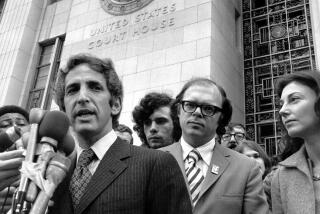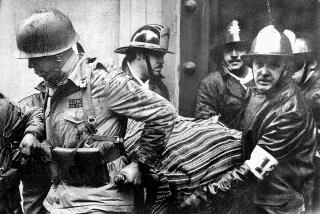Tapes Show Blunt Side of Nixon White House
- Share via
WASHINGTON — When President Nixon’s ambassador to France got roaring drunk and began groping the female flight attendants on a trip home from Paris, the president didn’t see that much to get excited about.
“Look, people get drunk,” Nixon said after a Jack Anderson column regaled readers with a graphic account of Ambassador Arthur Watson’s behavior on a March 1972 flight to Washington. “People chase girls. And the point is, it’s a . . . lot better for them to get drunk than to take drugs. It’s better to chase girls than boys.
“Now that’s my position and let’s stop this . . ,” Nixon declared at a March 14, 1972, Oval Office meeting with his chief of staff, H.R. Haldeman. “Understand?”
The episode, which prompted Democratic congressional demands for an investigation and Watson’s resignation, is one of thousands chronicled on 426 hours of White House tapes released Thursday.
The new batch deals with the tumultuous first half of 1972, which included Nixon’s historic trip to China, a fierce battle over the Democratic presidential nomination, and an assassination attempt that crippled Alabama Gov. George C. Wallace at the height of his popularity. The tapes also included what the White House sought to dismiss as a “third-rate burglary” at the Democratic National Committee headquarters in the Watergate complex.
At one point, in a discussion with national security advisor Henry A. Kissinger about intensified bombing of North Vietnam, Nixon abruptly suggested a nuclear strike. But he may have just been trying to get a rise out of Kissinger, who quickly played down the idea.
Through it all, Nixon kept a shrewd eye on the Democrats who wanted to challenge his reelection. He frequently expressed bafflement over Democrats’ embrace of Sen. George S. McGovern of South Dakota, who won the nomination. More worried about Sen. Edward M. Kennedy of Massachusetts, who never entered the race, Nixon dismissed McGovern with expletives and called him a “socialist with a blind spot for communists.”
“The Democratic Party is going through the throes of a suicide, which is fine,” former Treasury Secretary John B. Connally told Nixon on May 9, 1972, after Connally had become head of Democrats for Nixon.
Both talked of the nation’s chaotic, antiwar mood. The president said the news media was “one of the major culprits” in creating the negativism.
Talk shifted to what Nixon, “without getting into any anti-Semitism,” described as the inordinate influence of “a terrible liberal Jewish clique.” Connally said there was too much of it in government as well.
“Oh! Oh, God!” Nixon said with a sigh. “It erodes our confidence, our strength. They’re untrustworthy. . . . Look at the Justice Department, it’s full of Jews.”
“Any place of power,” Connally agreed. “[The Securities and Exchange Commission] used to be--all of them, those lawyers.”
“Listen, the lawyers in government are . . . Jews,” Nixon said.
Both agreed that Nixon should try to reduce the Jewish influence in a second term. Nixon told Connally on May 15 that he wanted no more than 2% of the government’s political appointees to be Jewish, in proportion to the population. He later said 10% would be acceptable, “but certainly not 30% or 40%.”
Nixon kept such views closely held. In a June 21, 1972, meeting with Federal Reserve Chairman Arthur F. Burns, the president listened quietly as Burns told him of “a profound change” in Jewish attitudes toward Nixon.
“I’m talking about the Wall Street Jews,” Burns said. “They’re going to vote Republican and they’re going to contribute substantial sums. They already have.”
Burns, who was Jewish, told Nixon, “In all the years that I have known you, I have never heard of what even remotely resembles what could be interpreted as a touch of anti-Semitism or anti-Catholicism.”
More to Read
Get the L.A. Times Politics newsletter
Deeply reported insights into legislation, politics and policy from Sacramento, Washington and beyond. In your inbox twice per week.
You may occasionally receive promotional content from the Los Angeles Times.










